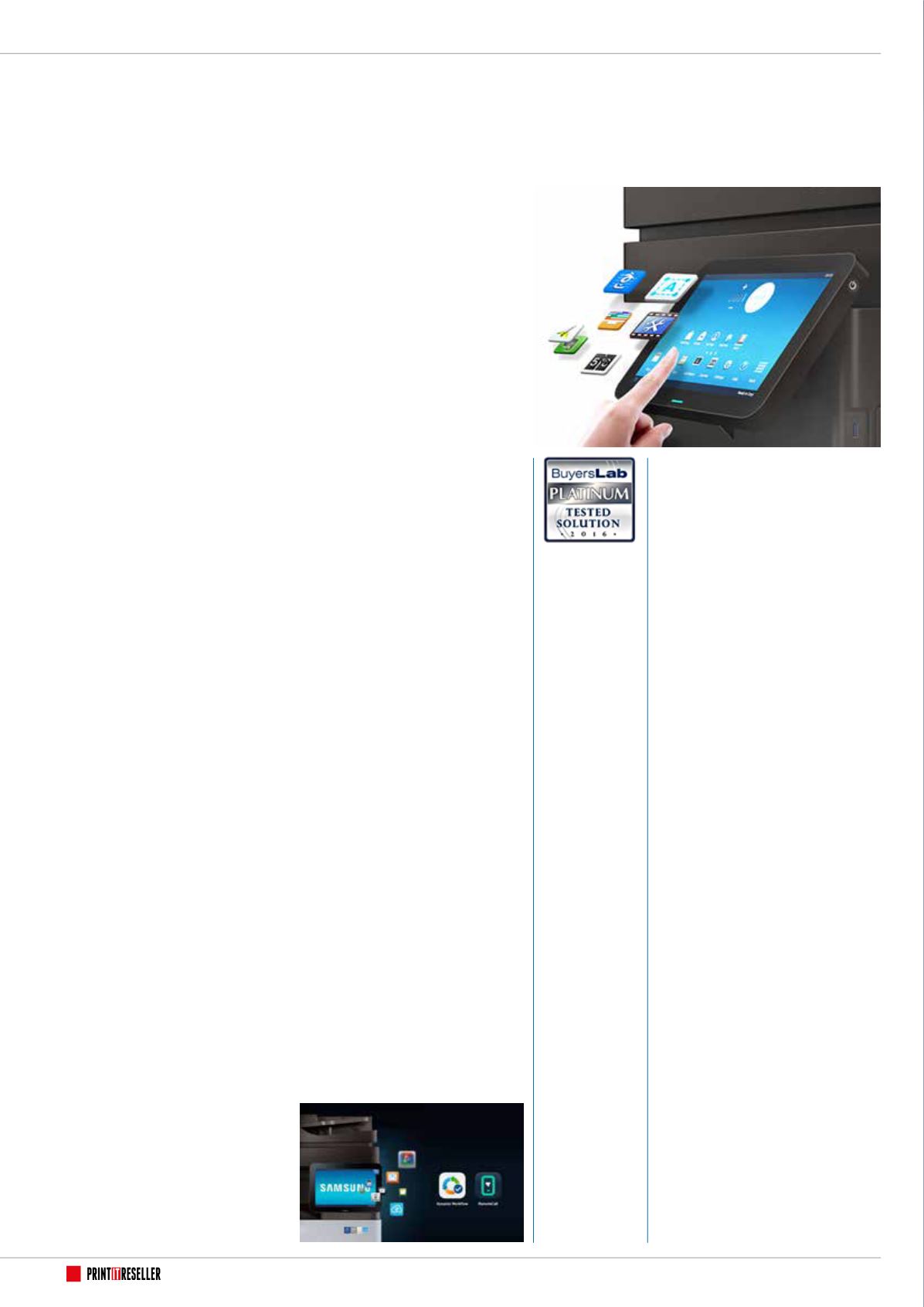
24
01732 759725
R&D
Samsung has a history of innovation in
diverse markets, from semiconductors
to smartphones and from household
appliances to office automation. After
three decades in the print industry – it
launched its first fax in 1982 and its
first laser printer in 1989 – Samsung
is drawing on its deep and varied
expertise in the development of new
printing solutions designed to fit
seamlessly into the IT and smart office
ecosystem.
This approach is clearly evident in the
company’s decision to use the Android
platform as the UI on its MultiXpress and
ProXpress series of MFPs. The devices’
Smart UX Center colour touch screen
display features the same touch-based,
customisable UX technology and tactile,
vibrating haptic technology as Samsung
Galaxy smartphones and tablets.
“Leveraging our strengths in mobile
for the first time, we have been able to
provide users with the same UI they use on
smartphones and tablets on their printers,
making the user experience the same across
both mobile and print,” explained Kim.
The Samsung UX Center is one of
Samsung’s IoT projects, converging
mobile technologies for an improved
office experience. It completes the office
printing ecosystem, allowing users to work
seamlessly from one device to the next.
Kim points out that this industry-first
development was driven by Dr. KiHo Kim,
Executive Vice President and Head of
Samsung’s Printing Solutions Business,
formerly head of Corporate R&D at
Samsung Electronics.
“Dr. Kim really understands the market
and was very clear in the direction that we
would take as a company. He chose the
cloud and mobile as Samsung’s USPs and
this is where we differentiate from other
brands,” Kim explained.
App development
With a suite of hardware supporting easy
customisation and improved productivity,
the obvious next step, says Kim, was to
create apps that can be installed on the
devices. “It was the simplest way to create
customised solutions for our MFPs to
address customer pain points,” he said.
For the channel, apps offer huge
opportunities for resellers to differentiate
themselves and create an incremental
revenue stream.
Last year, Samsung introduced the
Smart UX Center SDK, an open interface kit
for Smart UX providing a comprehensive
suite of features and tools that allow
app developers to integrate a wide range
of printer functions into an easy-to-use
user interface. The most recent update
introduces exciting new features including
mobile compatibility.
The Smart UX portfolio includes a total
of 36 apps so far, and there are currently
330 active developers signed up to the
SDK.
Future plans
Kim says that the functionality offered
by apps is integral to Samsung’s future
growth plans.
“Samsung’s primary focus is on
continuing to increase its share in the
office market. Looking ahead to the
future, we will continue to be responsive
to market requirements and develop
value-added solutions that integrate
multifunction devices for smart office
environments,” he said.
From 2016 to 2018, Samsung aims to
increase its share of the B2B printing market
and shift its main focus from Segment 1
and 2 to Segment 3 and 4 and A3 devices.
The launch of the MX7, the first A3 MFP on
the market powered by a Quadcore CPU,
was part of Samsung's strategy to push into
the A3 printing market and strengthen its
position in the enterprise space.
At Samsung’s European Printing Partner Summit held last
month in Budapest,
PITR
caught up with Kasey Kim, Vice
President and Head of R&D at Samsung Printing Solutions
Business, to find out more about the company’s plans for print.
Innovation and the
future of print
Cloud and mobile
The combination of Samsung hardware
and print services is already making waves
in the industry. In its MarketScape report
on the managed print and document
services (MPDS) industry, IDC recognises
Samsung as a major player, highlighting
its use of emerging cloud and mobile
technologies, as well as its intuitive
hardware products and value-added
services that extend beyond print. These
include business process management,
mobile print, mobile capture and digital
signature services.
Not surprisingly for a company with its
heritage, Samsung will continue to pursue
a mobile-first strategy with its printers.
“Mobile printing will continue to gain
traction, but we are not there yet,” said
Kim. “The data we collect via PrinterOn
shows it is growing exponentially and we
are confident it will become mainstream in
the future. We want to be the number one
vendor and we are setting the standard,
leading the paradigm shift towards the
smart and mobile office.”
In the meantime, Samsung will continue
to invest heavily in R&D. It commits
‘significant’ investment to research and
development each year and has research
labs sited worldwide, enabling it to tap
into local expertise across the globe,
develop innovative solutions to customer
pain points and exploit new opportunities
as they emerge.
One of these could be 3D print.
Whilst there are no immediate plans to
enter the 3D printing market, Kim hints
that Samsung is looking closely at the
technology. “We believe the biggest usage
will be in replacing consumable parts,”
he said. “We will continue to monitor the
market; develop IP and 3D technology;
and, when the scale is right, we will look at
entering the market.”
The Smart
UX portfolio
includes a total
of 36 apps so
far, and there
are currently
330 active
developers
signed up to
the SDK


